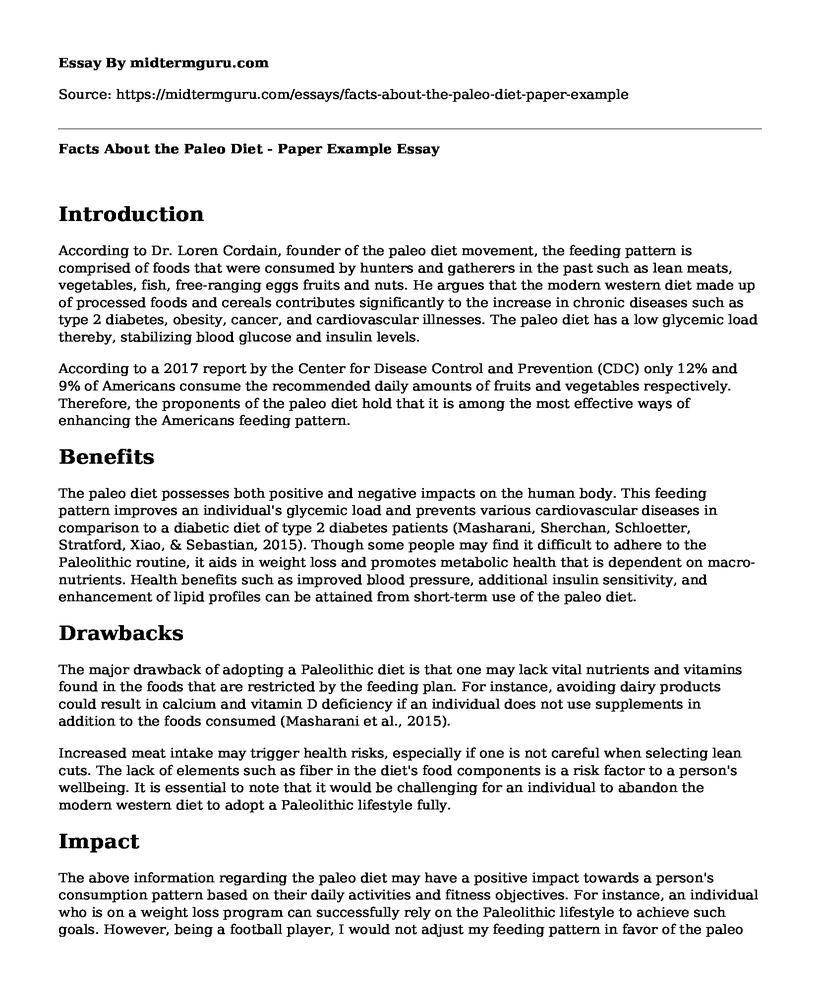Introduction
According to Dr. Loren Cordain, founder of the paleo diet movement, the feeding pattern is comprised of foods that were consumed by hunters and gatherers in the past such as lean meats, vegetables, fish, free-ranging eggs fruits and nuts. He argues that the modern western diet made up of processed foods and cereals contributes significantly to the increase in chronic diseases such as type 2 diabetes, obesity, cancer, and cardiovascular illnesses. The paleo diet has a low glycemic load thereby, stabilizing blood glucose and insulin levels.
According to a 2017 report by the Center for Disease Control and Prevention (CDC) only 12% and 9% of Americans consume the recommended daily amounts of fruits and vegetables respectively. Therefore, the proponents of the paleo diet hold that it is among the most effective ways of enhancing the Americans feeding pattern.
Benefits
The paleo diet possesses both positive and negative impacts on the human body. This feeding pattern improves an individual's glycemic load and prevents various cardiovascular diseases in comparison to a diabetic diet of type 2 diabetes patients (Masharani, Sherchan, Schloetter, Stratford, Xiao, & Sebastian, 2015). Though some people may find it difficult to adhere to the Paleolithic routine, it aids in weight loss and promotes metabolic health that is dependent on macro-nutrients. Health benefits such as improved blood pressure, additional insulin sensitivity, and enhancement of lipid profiles can be attained from short-term use of the paleo diet.
Drawbacks
The major drawback of adopting a Paleolithic diet is that one may lack vital nutrients and vitamins found in the foods that are restricted by the feeding plan. For instance, avoiding dairy products could result in calcium and vitamin D deficiency if an individual does not use supplements in addition to the foods consumed (Masharani et al., 2015).
Increased meat intake may trigger health risks, especially if one is not careful when selecting lean cuts. The lack of elements such as fiber in the diet's food components is a risk factor to a person's wellbeing. It is essential to note that it would be challenging for an individual to abandon the modern western diet to adopt a Paleolithic lifestyle fully.
Impact
The above information regarding the paleo diet may have a positive impact towards a person's consumption pattern based on their daily activities and fitness objectives. For instance, an individual who is on a weight loss program can successfully rely on the Paleolithic lifestyle to achieve such goals. However, being a football player, I would not adjust my feeding pattern in favor of the paleo diet since it only advocates for a high protein diet from grass-fed meat and seafood, fruits and vegetables. My nutritional routine comprises of high protein, carbohydrates with fat and additional supplements to meet the daily requirements. Sporting activities require high energy levels which cannot be achieved from a Paleolithic lifestyle. Also, the diet may compromise my role as a player due to probable insufficient calcium and vitamin D levels arising from failure to consume dairy products.
Additional information regarding the paleo diet can be found at the institute of medicine and other scientific research-based articles that discuss the feeding pattern in detail. There are also various nutrition experts who also have elaborated the paleo diet extensively.
Discussion Questions
What is your take on the paleo diet?
How does your current consumption routine relate to the Paleolithic lifestyle?
Explain your opinion regarding the benefits of a paleo diet while considering the potential lack of vital nutrients in the foods recommended for the routine. Do you think it is worth adopting?
References
Cordain, L., & O'Keefe, J. (2004). The Hunter-Gatherer Diet: In Response. Mayo Clinic Proceedings, 79(5), 703-707. doi: 10.4065/79.5.703-a
Masharani, U., Sherchan, P., Schloetter, M., Stratford, S., Xiao, A., & Sebastian, A. (2015). Metabolic and physiologic effects from consuming a hunter-gatherer (Paleolithic)-type diet in type 2 diabetes. European Journal of Clinical Nutrition, 69(8), 944-948. doi: 10.1038/ejcn.2015.39
Tarantino, G., Citro, V., & Finelli, C. (2015). Hype or reality: should patients with metabolic syndrome-related NAFLD be on the Hunter-Gatherer (Paleo) diet to decrease morbidity? Journal Of Gastrointestinal And Liver Diseases, 24(3), 359-365. doi: 10.15403/jgld.2014.1121.243.gta
Cite this page
Facts About the Paleo Diet - Paper Example. (2022, Aug 31). Retrieved from https://midtermguru.com/essays/facts-about-the-paleo-diet-paper-example
If you are the original author of this essay and no longer wish to have it published on the midtermguru.com website, please click below to request its removal:
- Essay Example: Why Go Vegan?
- Differences in Nutritional Needs Throughout Lifecycle - Essay Example
- Personal Dietary Records Paper Example
- SMART Goals: Diet Analysis Project
- Men's Dieting: Achieving Healthy Body Image in Regulated Manner - Essay Sample
- Fad Diets - Essay Sample
- Eat Healthy: Nutrition and Its Essential Role in Health - Essay Sample







